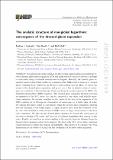| dc.contributor.author | Neill, Duff | |
| dc.contributor.author | Larkoski, Andrew J. | |
| dc.contributor.author | Moult, Ian James | |
| dc.date.accessioned | 2016-12-08T18:18:46Z | |
| dc.date.available | 2016-12-08T18:18:46Z | |
| dc.date.issued | 2016-11 | |
| dc.date.submitted | 2016-09 | |
| dc.identifier.issn | 1029-8479 | |
| dc.identifier.uri | http://hdl.handle.net/1721.1/105748 | |
| dc.description.abstract | Non-global logarithms (NGLs) are the leading manifestation of correlations between distinct phase space regions in QCD and gauge theories and have proven a challenge to understand using traditional resummation techniques. Recently, the dressed gluon ex-pansion was introduced that enables an expansion of the NGL series in terms of a “dressed gluon” building block, defined by an all-orders factorization theorem. Here, we clarify the nature of the dressed gluon expansion, and prove that it has an infinite radius of convergence as a solution to the leading logarithmic and large-Nc master equation for NGLs, the Banfi-Marchesini-Smye (BMS) equation. The dressed gluon expansion therefore provides an expansion of the NGL series that can be truncated at any order, with reliable uncertainty estimates. In contrast, manifest in the results of the fixed-order expansion of the BMS equation up to 12-loops is a breakdown of convergence at a finite value of αslog. We explain this finite radius of convergence using the dressed gluon expansion, showing how the dynamics of the buffer region, a region of phase space near the boundary of the jet that was identified in early studies of NGLs, leads to large contributions to the fixed order expansion. We also use the dressed gluon expansion to discuss the convergence of the next-to-leading NGL series, and the role of collinear logarithms that appear at this order. Finally, we show how an understanding of the analytic behavior obtained from the dressed gluon expansion allows us to improve the fixed order NGL series using conformal transformations to extend the domain of analyticity. This allows us to calculate the NGL distribution for all values of αslog from the coefficients of the fixed order expansion. | en_US |
| dc.description.sponsorship | United States. Dept. of Energy (DE-FG02-05ER-41360, DE-SC0011090, DE-AC52-06NA25396) | en_US |
| dc.description.sponsorship | Los Alamos National Laboratory (Laboratory Directed Research & Development) | en_US |
| dc.publisher | Springer Berlin Heidelberg | en_US |
| dc.relation.isversionof | http://dx.doi.org/10.1007/JHEP11(2016)089 | en_US |
| dc.rights | Creative Commons Attribution | en_US |
| dc.rights.uri | http://creativecommons.org/licenses/by/4.0/ | en_US |
| dc.source | Springer Berlin Heidelberg | en_US |
| dc.title | The analytic structure of non-global logarithms: convergence of the dressed gluon expansion | en_US |
| dc.type | Article | en_US |
| dc.identifier.citation | Larkoski, Andrew J., Ian Moult, and Duff Neill. “The Analytic Structure of Non-Global Logarithms: Convergence of the Dressed Gluon Expansion.” Journal of High Energy Physics 2016.11 (2016): n. pag. | en_US |
| dc.contributor.department | Massachusetts Institute of Technology. Center for Theoretical Physics | en_US |
| dc.contributor.mitauthor | Moult, Ian James | |
| dc.relation.journal | Journal of High Energy Physics | en_US |
| dc.eprint.version | Final published version | en_US |
| dc.type.uri | http://purl.org/eprint/type/JournalArticle | en_US |
| eprint.status | http://purl.org/eprint/status/PeerReviewed | en_US |
| dc.date.updated | 2016-11-17T04:37:57Z | |
| dc.language.rfc3066 | en | |
| dc.rights.holder | The Author(s) | |
| dspace.orderedauthors | Larkoski, Andrew J.; Moult, Ian; Neill, Duff | en_US |
| dspace.embargo.terms | N | en_US |
| dc.identifier.orcid | https://orcid.org/0000-0002-4819-4081 | |
| mit.license | PUBLISHER_CC | en_US |
